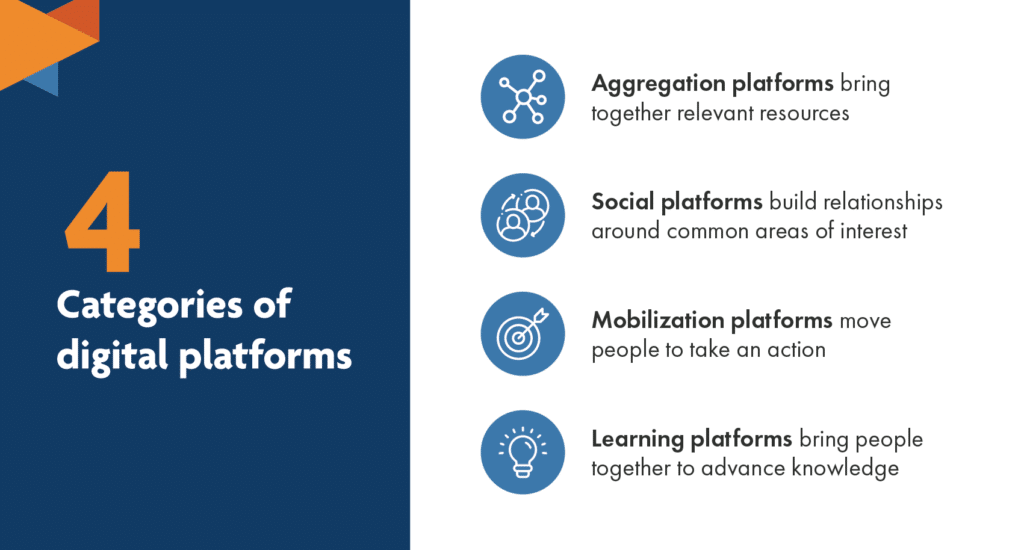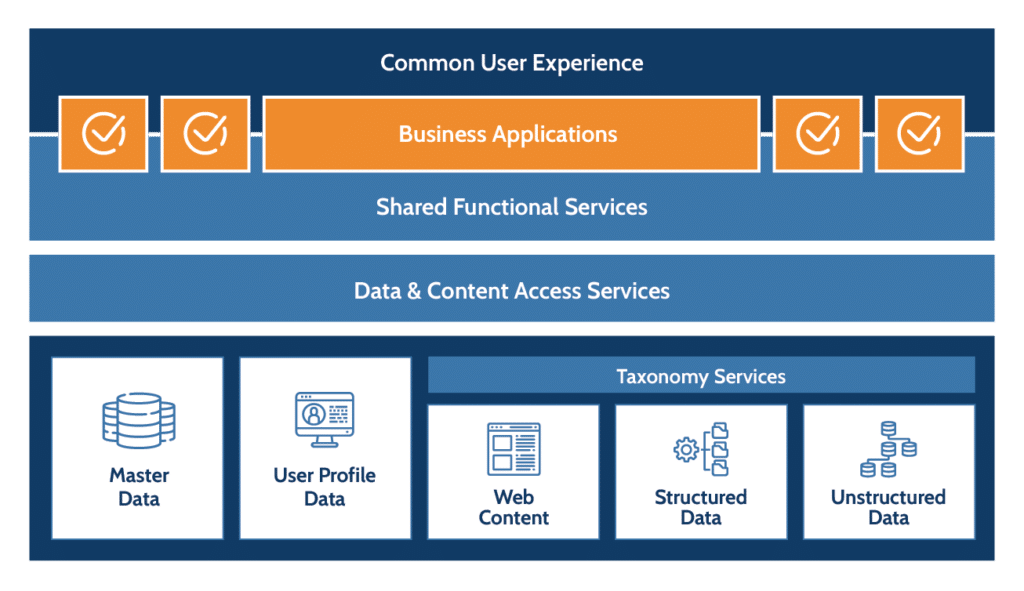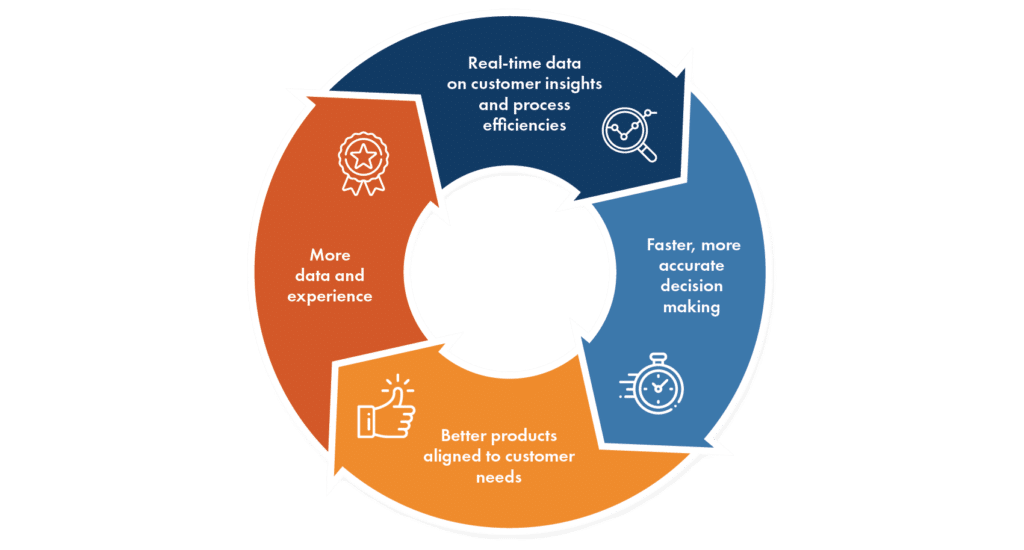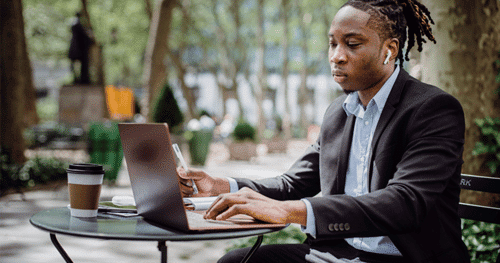Most business leaders today know the word “platform” has morphed beyond its traditional Oxford English Dictionary definition as either “a raised level surface on which people or things can stand” or “the declared policy of a political party or group.” When a recent U.S. president got “de-platformed,” most of us understood that meant he was kicked off Twitter and other major social media websites.
But fewer executives fully understand what the term means in the business world, or why they might need one. Searches for the phrase “digital platform” hit a new peak last September, with the term doubling in interest since October 2019, according to Google Trends.

To help you more effectively incorporate these key insights into strategic conversations, we first need to define what is meant by a “digital platform”, and then discuss how to establish a digital platform strategy and why you need to adopt a platform mindset to be successful in today’s digital economy.
What do we mean by ‘digital platform’?
Think of it like an ecosystem: A digital platform is a combination of culture, services, data and technology upon which additional innovation and value can be rapidly and efficiently delivered.
Digital platforms can add value by enabling service innovation for customers and clients, fostering more efficient ways of working, revealing new insights from operational data – or likely a combination of all three.
A recent Deloitte study on the topic describes four categories of digital platforms:

Business platforms can embrace any combination of these categories. But what’s common is a mindset that values creating an environment in which customers can learn about and consume your products and services. Companies like Salesforce build platform businesses that enable customers and partners to create additional value on top of their platform.
Other organizations like Netflix and Uber use a platform strategy to accelerate internal delivery of services and value to consumers. In both cases the necessary ingredients for a successful digital platform approach remain the same.
Successful adoption of a digital platform business model requires:
- An adaptable and problem-solving staff
- Clarity regarding the core set of services shared across teams and organizations
- Understanding of the centrality and importance of data as the lifeblood asset of the company
- An integrated, scalable, agile and reliable technology foundation
Digital platforms – the basics
The graphic below shows the elements that comprise many modern digital platforms. These models are best read from the bottom up: User profile data, web content and other data power a series of services, which drive front-end business applications for the user.
These applications and services are presented via a common user interface.

Why growth depends on a digital platform strategy
Organizations with platform-based business models have a number of inherent advantages over organizations with a more traditional structure and operating model. Product development is typically faster because building on top of shared platform services accelerates implementation cycles. It also accelerates the speed which new services and features can be released based on real customer evidence and feedback.
Decision-making is also faster using a platform approach over traditional, hierarchically governed organizations. Central is the notion of continuous improvement based on a recurring feedback loop:

Capturing a growing share of revenue enables more aggressive reinvestment in underlying platform capabilities, which reinforces the built-in advantage of the positive digital platform feedback loop. Organizations that optimize and build on these platform-enabled feedback processes tend to pull away at an increasing rate from their more traditional competitors.
Adopting a digital platform culture
Platforms differ from traditional business models by emphasizing horizontal integration of data, processes and services across organizational boundaries. Traditional business models depend on hierarchical decision-making and emphasize specialization and ownership within functionally distinct organizational boundaries.
Platform-based approaches typically require a flatter organization with networked collaboration and decision-making processes that focus on responsiveness by pushing decision-making authority closer to the point of engagement with the customer or client.
The imperative to push decision making away from traditional hierarchical leadership roles toward empowered and enabled members of staff places a premium on adaptability, higher level problem solving and analytical skills.

Successful digital platform organizations hire talent that can flex between different roles and can continuously develop new skills and capabilities. These organization focus on empowering staff to make decisions based on data with readily available access to the data and required analytical tools.
Data: The lifeblood of digital platform-based business models
Accurate, real or near real-time operational data is the foundation of fast, precise decision making. It all leads to better product and service designs, and continuous improvement in business operations efficiency.
Platform-based businesses invest heavily in the technical data landscapes that provide a 360-degree view of the business and are able to ingest, process and distribute data as efficiently as possible to the staff and systems driving the business forward.
Continuous, ongoing Investment in the analytics tools required to use data to inform business decisions is critical.
Creating standard services for your business platform
One of the keys to driving growth with a platform business model is the ability to identify common processes across the organization and to turn these into shared automated services within the technical landscape.
The creation of a set of common shared platform services fosters two significant benefits for the organization.
- Benefit 1: Decision-making and transactional friction is dramatically reduced by adopting standard service definitions.
- Benefit 2: Time-to-market to introduce new products and services is radically improved by building new capabilities from a reusable set of “Lego” building blocks.
Technology basics for powering a digital platform business
Platform-based businesses almost always base their technical architectures on modern cloud-based, scalable design and operating principles. The elastic nature of cloud-based architectures and the ease with which integrated data landscapes can be provisioned and operated makes these the optimal environments for delivery and management of digital platform services.
Some of the world’s largest and most successful platform companies – including Netflix, Facebook, Twitter, Uber and Spotify – make much of their platform capabilities available via open-source code. Organizations embarking on building out platform-based technical infrastructures can accelerate their journey by reusing the building blocks made freely available by these companies and others.
Building these technical platform capabilities from scratch often does not make sense for an organization.
Fortunately, there are an increasing number of very sophisticated and fully managed platform services available from the main cloud platform providers, such as Amazon Web Services, Microsoft Azure and Google’s Cloud Platform. Adoption of a technical architecture and landscape based on these fully managed services radically reduce an organization’s need to invest in technical operating capabilities and the associated fixed in-house costs.
The advantages of developing a digital platform business model are increasingly clear to all types of businesses and organizations who are committed to growth, innovation, and defining the future for their customers and marketplaces. Success depends on developing the organizational rigor and internal operating discipline to embrace required change and effectively develop and execute an enterprise-wide platform approach.
Wondering how can you apply the thinking behind digital platforms for your enterprise? Let us know if you’d like to chat further.

















